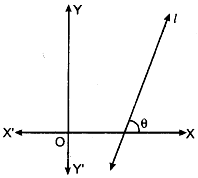In this section we shall use differentiation to find the equation of the tangent line and the normal line to a curve at a given point.
A line which touches the curve at a single point is called tangent at a point and if a line is perpendicular to the tangent at the point of contact, then it is called normal.
Slope of a line: The trigonometrical tangent of the angle that a line makes with the positive direction of X-axis in anti-clockwise direction is called the slope or gradient of the line. The slope of line is generally denoted by m.
Thus, slope of line m = tan θ

Slope of line by equation of line:
Let equation of line be ax + by + c = 0, then slope of line is m such that:
m = \(\frac{-a}{b} = - \frac{\text {coefficient of x}}{\text{coefficient of y}}\)
Note that the slope of the tangent to the curve y = f(x) the point (x0, y0) is given by \(\frac{dy}{dx}]_{x_0,y_0}\) = f'(x0)). So the equation of the tangent at (x0, y0) to the curve y = f (x) is given by

Also, since the normal is perpendicular to the tangent, the slope of the normal to the curve y = f (x) at (x0, y0) is \(\frac{-1}{f'(x_0)}\) if f' (x0) ≠ 0.
Therefore, the equation of the normal to the curve y = f(x) at (x0, y0) is given by
y - y0 = \(\)\(\frac{-1}{f'(x_0)}\) (x -x0)
i.e (y - y0)f' (x0) + (x - x0) = 0
Note:
If a tangent line to the curve y = f(x) makes an angle θ with x-axis in the positive direction, then \(\frac{dy}{dx}\) = slope of the tangent = tan θ.
Particular cases
- If slope of the tangent line is zero, then tan θ = 0 and so θ = 0° which means the tangent line is parallel to the x-axis. In this case, the equation of the tangent at the point (x0, y0) is given by y = y0.
- If, θ = \(\frac{\pi}{2}\) then tan θ = ∞, which means the tangent
line is perpendicular to the x-axis, i.e., parallel to the y-axis. In this case, the equation of the tangent at (x0, y0) is given by x = x0.